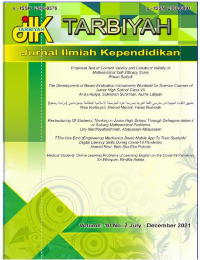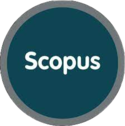The Use Emb (Engineering Mechanics Book) Mobile App To Train Students’ Digital Literacy Skills During Covid-19 Pandemic
DOI:
https://doi.org/10.18592/tarbiyah.v10i2.5542Abstract
Learning media plays an essential role in conveying material to students. Learning media can be divided into media that Teacher directly use in learning and media made by Teacher that later adapted to the abilities and needs of students. Engineering mechanics is one of the primary subjects that civil engineering students must master at. The engineering mechanics course discusses the analysis of the balance of a structure. Students can use mobile application-based teaching materials as online learning media amid the COVID-19 pandemic. Engineering mechanics book, we called EMB, can be used by students to study independently at home during learning online but still in the monitoring/monitoring of Teacher (lecturers). The research and development use ADDIE design. The stage includes 1) Analysis, 2) Design, 3) Develop, 4) Implementation, and 5) Evaluation. EMB product had been tested the validity and implementation during the learning process. EMB got 3.32 valid results for the product. EMB can also train students in digital literacy. Students' digital literacy is in the quite proficient category. This condition is not regardless of the influence of student habits in using technology which is more often used for online communication and entertainment. The frequency of using digital technology for entertainment purposes is higher compared to use for academic purposes.References
Alexander, B., Becker, S. A., Cummins, M., & Giesinger, C. H. (2017). Digital literacy in higher education, part ii: an nmc horizon project strategic brief (pp. 1–37). The New Media Consortium. https://www.learntechlib.org/p/182086/
Al-Qallaf, C. L., & Al-Mutairi, A. S. R. (2016). Digital literacy and digital content supports learning: the impact of blogs on teaching english as a foreign language. The Electronic Library, 34(3), 522–547. https://doi.org/10.1108/EL-05-2015-0076
Becker, B., W. (2021).“Information literacy in the digital age: myths and principles of digit” by Bernd W. Becker. (n.d.). Retrieved November 12, 2021, from https://scholarworks.sjsu.edu/ischoolsrj/vol7/iss2/2/
Griffin, P., & Care, E. (2015). Assessment and teaching of 21st century skills | SpringerLink. (n.d.). Retrieved November 12, 2021, from https://link.springer.com/book/10.1007%2F978-94-017-9395-7
Güneş, E., & Bahçivan, E. (2018). A mixed research-based model for pre-service science teachers’ digital literacy | Computers & Education. (n.d.). Retrieved November 12, 2021, from https://dl.acm.org/doi/abs/10.1016/j.compedu.2017.11.012
Hakim, S. R., Kustijono, R., & Wiwin, E. (2019). The use of android-based teaching materials in physics learning process at vocational high school. 1171, 012024. https://doi.org/10.1088/1742-6596/1171/1/012024
Hartini, S., Susilowati, E., & Misbah, M. (2019). Media pembelajaran fisika sma berbasis e-learning di kabupaten tanah laut sebagai upaya melatihkan literasi digital. PRO SEJAHTERA (Prosiding Seminar Nasional Pengabdian kepada Masyarakat), 1(1), Article 1. http://snllb.ulm.ac.id/prosiding/index.php/snllb-abdimas/article/view/280
Hobbs, R., & Coiro, J. (2019). Design features of a professional development program in digital literacy. Journal of Adolescent & Adult Literacy, 62(4), 401–409. https://doi.org/10.1002/jaal.907
List, A. (2019). Defining digital literacy development: an examination of pre-service teachers’ beliefs. Computers & Education, 138, 146–158. https://doi.org/10.1016/j.compedu.2019.03.009
Maulani, A., Ayu, S. M., Dermawan, O., & Akmansyah, M. (2021). The development of android-based islamic education learning media. Tarbiyah : Jurnal Ilmiah Kependidikan, 10(1), 35–43. https://doi.org/10.18592/tarbiyah.v10i1.4410
Misbah, M., Pratama, W. A., Hartini, S., & Dewantara, D. (2018). Pengembangan e-learning berbasis schoology pada materi impuls dan momentum untuk melatihkan literasi digital. PSEJ (Pancasakti Science Education Journal), 3(2), 109-114.
Mishra, K.E., Wilder, K., Mishra, A.K. 2017. Digital literacy in the marketing curriculum: are female college students prepared for digital jobs? (n.d.). Retrieved November 12, 2021, from https://journals.sagepub.com/doi/abs/10.1177/0950422217697838
Nelson, K., Courier, M., & Joseph, G. (2011). An investigation of digital literacy needs of students. Journal of Information Systems Education, 22(2), 95–110.
Porat, E., Blau, I., & Barak, A. (2018). Measuring digital literacies: junior high-school students’ perceived competencies versus actual performance. Computers & Education, 126, 23–36. https://doi.org/10.1016/j.compedu.2018.06.030
Rahayu, T., Mayasari, T., & Huriawati, F. (2019). Pengembangan instrumen kemampuan literasi digital dalam penerapan media hybrid learning berbasis website fisika. SNPF (Seminar Nasional Pendidikan Fisika), 0, Article 0. http://prosiding.unipma.ac.id/index.php/SNPF/article/view/725
Rahayu, T., Mayasari, T., & Huriawati, F. (2019). Pengembangan media website hybrid learning berbasis kemampuan literasi digital dalam pembelajaran fisika. Jurnal Pendidikan Fisika, 7(1), 130–142. https://doi.org/10.24127/jpf.v7i1.1567
Rizal, R., Rusdiana, D., Setiawan, W., & Siahaan, P. (2020). The digital literacy of the first semester students in physics education. Jurnal Pendidikan Fisika, 8(2), 101–110. https://doi.org/10.26618/jpf.v8i2.3293
Setyaningsih, R., Abdullah, A., Prihantoro, E., & Hustinawaty, H. (2019). Model penguatan literasi digital melalui pemanfaatan e-learning. Jurnal ASPIKOM, 3(6), 1200–1214.
Sutisna, D., Widodo, A., Anar, A. P., Indraswati, D., & Nursaptini, N. (2020). Identification of mobile phone usage’s shifting among students. Tarbiyah : Jurnal Ilmiah Kependidikan, 9(2), 87–97. https://doi.org/10.18592/tarbiyah.v9i2.3519
Techataweewan, W., & Prasertsin, U. (2017). Development of digital literacy indicators for thai undergraduate students using mixed method research—ScienceDirect. (n.d.). Retrieved November 12, 2021, from https://www.sciencedirect.com/science/article/pii/S2452315116301254
Tondeur, J., Forkosh-Baruch, A., Prestridge, S., Albion, P., & Edirisinghe, S. (2016). Responding to challenges in teacher professional development for ict integration in education. Journal of Educational Technology & Society, 19(3), 110–120.
Wahyuni. (2012). Pengembangan bahan ajar fisika matematika berbasis self regulated learning sebagai upaya peningkatan kemampuan belajar mandiri, Jurnal Pendidikan Fisika Indonesia. (n.d.). Retrieved November 12, 2021, from https://journal.unnes.ac.id/nju/index.php/JPFI/article/view/1992
Wang, J., Jou, M., Lv, Y., & Huang, C.-C. (2018). An investigation on teaching performances of model-based flipping classroom for physics supported by modern teaching technologies. Computers in Human Behavior, 84, 36–48. https://doi.org/10.1016/j.chb.2018.02.018
Downloads
Published
How to Cite
Issue
Section
License
Authors retain copyright and grant the journal right of first publication with the work simultaneously licensed under a Creative Commons Attribution 4.0 International License that allows others to share the work with an acknowledgment of the work's authorship and initial publication in this journal.




